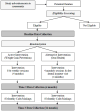Healthy families study: design of a childhood obesity prevention trial for Hispanic families
- PMID: 23624172
- PMCID: PMC3749297
- DOI: 10.1016/j.cct.2013.04.005
Healthy families study: design of a childhood obesity prevention trial for Hispanic families
Abstract
Background: The childhood obesity epidemic disproportionately affects Hispanics. This paper reports on the design of the ongoing Healthy Families Study, a randomized controlled trial testing the efficacy of a community-based, behavioral family intervention to prevent excessive weight gain in Hispanic children using a community-based participatory research approach.
Methods: The study will enroll 272 Hispanic families with children ages 5-7 residing in greater Nashville, Tennessee, United States. Families are randomized to the active weight gain prevention intervention or an alternative intervention focused on oral health. Lay community health promoters implement the interventions primarily in Spanish in a community center. The active intervention was adapted from the We Can! parent program to be culturally-targeted for Hispanic families and for younger children. This 12-month intervention promotes healthy eating behaviors, increased physical activity, and decreased sedentary behavior, with an emphasis on parental modeling and experiential learning for children. Families attend eight bi-monthly group sessions during four months then receive information and/or support by phone or mail each month for eight months. The primary outcome is change in children's body mass index. Secondary outcomes are changes in children's waist circumference, dietary behaviors, preferences for fruits and vegetables, physical activity, and screen time.
Results: Enrollment and data collection are in progress.
Conclusion: This study will contribute valuable evidence on efficacy of a childhood obesity prevention intervention targeting Hispanic families with implications for reducing disparities.
Trial registration: ClinicalTrials.gov NCT01156402.
Keywords: Children; Cluster-randomized controlled trial; Hispanics; Obesity prevention; Overweight; We Can.
Copyright © 2013 Elsevier Inc. All rights reserved.
References
-
- Ogden C, Carroll MD. Prevalence of overweight, obesity, and extreme obesity among adults: United States, trends 1960–1962 through 2007–2008. NCHS Health E-Stat. 2010;1994:1–6.
-
- Gortmaker SL, Dietz WH, Jr, Cheung LW. Inactivity, diet, and the fattening of America. Journal of the American Dietetic Association. 1990;90:1247–52. 55. - PubMed
-
- Fitzgibbon M. National Heart LaBI, editor. Healthy Weight: Community Outreach Initiative: Strategy Development Report. Washington, D.C: NHLBI; 2005. Obesity: What are the challenges, obstacles, and strategic considerations; pp. 6–9.
-
- Freedman DS, Dietz WH, Srinivasan SR, Berenson GS. The relation of overweight to cardiovascular risk factors among children and adolescents: The Bogalusa Heart Study. Pediatrics. 1999;103:1175–82. - PubMed
Publication types
MeSH terms
Associated data
Grants and funding
LinkOut - more resources
Full Text Sources
Other Literature Sources
Medical


